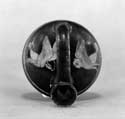
ESSAYS
by Meghan Gandy
"Homer's
Odyssey in the Past"
"Homer's Odyssey in the Present"
[
"Greek Vases with Themes from Homer's Odyssey" ]

Greek, Attic, ca. 470-460 B.C.
Attributed to the Amphitrite Painter
Princeton University Art Museum
Museum purchase, gift of Joyce von Bothmer, y 1989, 84
the rams went rambling out of the cave toward pasture...
...Their master now, heaving in torment, felt the back of each animal
halting before him here, but the idiot never sensed
my men were trussed up under their thick fleecy ribs
And last of them all came my great ram now, striding out
weighed down with his dense wool and my deep plots (9.488-496).
Dated to approximately 470-460 B.C., this fragmentary red-figure cup by the Amphitrite Painter features the popular scene of Odysseus' clever escape from the cave of Polyphemus. Originally a single file procession of rams extended around the cup, broken by decorative palmettes under the handles. Two partial rams remain with men tied under them. The figure of Polyphemus is shown sitting on a rock near the preserved handle. His upper body and head are now missing, but the brutality and monstrousness of the Cyclops is conveyed through the use of body hair and the club he holds in his left hand.

Greek, Attic, ca. 460-450 B.C.
Princeton University Art Museum
Museum purchase, Trumbull-Prime Fund,
y1927,916
whoever comes their way. Whoever draws too close,
off guard, and catches the Sirens' voices in the air--
no sailing home for him... The high, thrilling song of the Sirens will transfix him,
lolling there in their meadow, round them heaps of corpses... (12:44-51).
This is Circe's warning to Odysseus about the mythical Sirens. While she vividly describes their song, she does not give any physical description of these terrifying creatures. Nevertheless, the Sirens were frequently depicted in art, appearing as bird-bodied women. The red figure askos in this exhibit shows the Sirens, although not Odysseus' encounter with them. They are shown in profile on the body of the askos facing the spout, both with distinctly feminine and beautiful faces. The presence of only two Sirens, matching the Homeric account, makes an association with the Odyssey probable. The funerary function of the askos, which was used to pour libations to the dead, further connects the vessel to the Odyssey Sirens, who draw men towards death with their seductive song. During the fifth century BC Sirens became a popular element of Greek funerary decoration and it was believed that they helped the deceased make their transition into the Underworld.